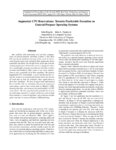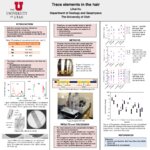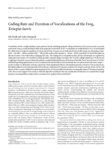|
|
Creator | Title | Description | Subject | Date |
| 26 |
 |
Liu, Feng | Metal-to-semiconductor transition in squashed armchair carbon nanotubes | We investigate electronic transport properties of the squashed armchair carbon nanotubes, using tight-binding molecular dynamics and the Green's function method. We demonstrate a metal-to-semiconductor transition while squashing the nanotubes and a general mechanism for such a transition. It is the ... | Squashed armchair; Carbon nanotubes; Metal-to-semiconductor transition; Electronic transport; Tight-binding molecular dynamics; Squashed nanotubes | 2003-04 |
| 27 |
 |
Olson, Randall J. | Comparison of thermal features associated with 2 phacoemulsification machines | PURPOSE: To determine the thermal characteristics of the Legacy Advantec and Sovereign WhiteStar phacoemulsification machines during different clinically relevant scenarios. SETTING: In vitro study. METHODS: In water, temperature was recorded continuously on the sleeve in an artificial chamber, and ... | Cataracts; Wound Burns; Thermal Characteristics | 2006-02 |
| 28 |
 |
Ring, Terry Arthur | Room temperature co-precipitation synthesis of magnetite nanoparticles in a large pH window with different bases | Magnetite nanoparticles (Fe3O4) represent the most promising materials in medical applications. To favor high-drug or enzyme loading on the nanoparticles, they are incorporated into mesoporous materials to form a hybrid support with the consequent reduction of magnetization saturation. The direct sy... | | 2013-01-01 |
| 29 |
 |
DeTar, Carleton | Results for light pseudoscalars from three-flavor simulations | We compute pseudoscalar meson masses and decay constants in partially quenched QCD with three dynamical flavors of improved staggered quarks. Fitting the lattice data to staggered chiral perturbation theory (SX_x001F_PT) forms and extrapolating in quark mass and lattice spacing, we find: frr = 129... | Pseudoscalars; Decay constants; Staggered quarks | 2005-03 |
| 30 |
 |
Horch, Kenneth W.; Christensen, Douglas A. | Accelerated 4-year bachelors/masters degree program in biomedical engineering | In response to the need for providing advanced engineering education in a shorter time period than is currently possible by traditional curricula, we have created an Accelerated Dual Degree program in biomedical engineering. The purpose of this pilot program is to attract the brightest students, g... | Accelerated dual-degree program | 2002 |
| 31 |
 |
Horch, Kenneth W.; Christensen, Douglas A. | Accelerated 4-year bachelors/masters degree program in biomedical engineering | In response to the need for providing advanced engineering education in a shorter time period than is currently possible by traditional curricula, we have created an Accelerated Dual Degree program in biomedical engineering. The purpose of this pilot program is to attract the brightest students, g... | Accelerated; Dual-degrees; Education | 2002 |
| 32 |
 |
Vardeny, Zeev Valentine | Transient spectroscopy of Frenkel and charge transfer excitons in α-sexithienyl films | Photoexcitations dynamics are investigated in a-sexithienyl nanocrystalline films using transient photomodulation in a spectral range from 0.4 to 2.5 eV and time domain from 200 fs to 50 ms. We identify intrachain and interchain excitations. The former are even parity excitons with ultrafast dynami... | Transient spectroscopy; Excitons; Frenkel exciton; Charge transfer exciton; Transient photomodulation | 1997-10 |
| 33 |
 |
Miller, Joel Steven; Epstein, Arthur J. | Effect of solvent on the magnetic properties of the high-temperature V[TCNE]x molecule-based magnet | The different magnetic behaviors of the V[TCNE]x (TCNE=tetracyanoethylene) magnet prepared via the reaction of TCNE and V(CO)6 in CH2Cl2 and the solvent-free chemical vapor deposition (CVD) of TCNE and V(CO)6 onto a glass substrate were determined. It was shown that the presence of noncoordinating C... | Magnetization; Molecule | 2001 |
| 34 |
 |
Miller, Jan D. | Effect of ink types and printing processes on flotation deinking | Examination of ink types reveals that newsprint oil-based offset-cold and offset-heat inks contain substantial oil (45 to 60%) and resin (5 to 35%), water-based ink contains water (40%) and resin (polystyrene, 30%). These inks are liquids with densities around 1 g/cm3, having various viscosities... | Toners; Inks; Photocopying; Laser printing; Flotation; Deinking; Recycling; Office waste; Hyrdophobicity | 1997 |
| 35 |
 |
Lombardo, Nancy T.; Bramble, John | PDA operating system comparison | A LIFT Forum presentation. The purpose of the Library and Information Technology Forum is to inform the University of Utah community about electronic information resources, and current trends in the use of computers and online technologies for accessing these resources | PDA; Personal Digital Assistants; Computers, Handheld | 2002-10-09 |
| 36 |
 |
Jarrard, Richard D. | Data report: high-resolution mineralogy for leg 199 based on reflectance spectroscopy and physical properties | During Ocean Drilling Program Leg 199 in the equatorial Pacific, visible and near-infrared spectroscopy (VNIS) was used to measure the reflectance spectra (350?2500 nm) of 1343 sediment samples. Reflectance spectra were also measured for a suite of 60 samples of known mineralogy, thereby providing a... | | 2004 |
| 37 |
 |
| Research in brief: Spring 1999 | Summaries of Selected Research Projects at the University of Utah Health Sciences Center | Research: School of Medicine, College of Pharmacy;, College of Nursing, College of Health | 1999-09 |
| 38 |
 |
Pershing, David W. | Bench and pilot scale process evaluation of reburning for in-furnace NOx reduction | This paper describes a combined experimental and theoretical study which was undertaken to quantify the impact of fuel and process parameters on reburning effectiveness and provide the scaling information required for commercial application of reburning under highly varied industrial conditions. Ini... | Reburning; Nitrogen oxides reduction; Staged fuel injection | 1986 |
| 39 |
 |
Goller, Franz | Motor control of crystallized song is modified by sensory feedback | Song production requires precisely coordinated activity in the respiratory and syringcal (vocal organ) muscles. Crystallized adult song is characterized by acoustic and motor stereotypy which does not require auditory feedback, suggesting it is represented by fixed central motor programs. To determ... | Air injection; Auditory feedback; Pressure | 1997 |
| 40 |
 |
Lawton, Kristy J. | Motor neurons tune premotor activity in a vertebrate central pattern generator | Central patterns generators (CPGs) are neural circuits that drive rhythmic motor output without sensory feedback. Vertebrate CPGs are generally believed to operate in a top-down manner in which premotor interneurons activate motor neurons that in turn drive muscles. In contrast, the frog (Xenopus la... | CPG; feed back; synchrony; vocal; vocalization; Xenopus | 2017 |
| 41 |
 |
Miller, Jan D. | Thermogravimetric/Mass spectrometric (TG/MS) characterization of toner particles from photocopied wastepaper and the impact of these features on flotation deinking | Flotation deinking of photocopies from office waste is known to be much more difficult than the flotation deinking of newsprint. In this regard, research has been undertaken to better understand the phenomena which account for the poor efficiency in the flotation deinking of such office waste. Durin... | Photocopied paper; Recycling; Deinking; Flotation; Thermal decomposition; Thermogravimetry; Mass spectrometry; Differential scanning calorimeter; Toner particles | 1995 |
| 42 |
 |
DeTar, Carleton | Charmed-meson decay constants in three-flavor lattice QCD | We present the first lattice QCD calculation with realistic sea quark content of the D+-meson decay constant fD+. We use the MILC Collaboration's publicly available ensembles of lattice gauge fields, which have a quark sea with two flavors (up and down) much lighter than a third (strange). We obtain... | Flavor physics; Charmed meson; Staggered fermions | 2005-09 |
| 43 |
 |
Mo, Wenjing | Institutionalization among the elderly in Japan and China: a comparative study | | 2013 Center on Aging Poster Retreat | 2013 |
| 44 |
 |
| Page 34 | | | |
| 45 |
 |
DeTar, Carleton | Thermodynamics with 3 and 2+1 flavors improved staggered quarks | We present preliminary results [1] from exploring the phase diagram of finite temperature QCD with three degenerate flavors and with two light flavors and the mass of the third held approximately at the strange quark mass. We use an order _x000B_2 sa2, a4 Symanzik improved gauge action and an orde... | Staggered quarks | 2002-03 |
| 46 |
 |
Regehr, John | Augmented CPU reservations: towards predictable execution on general-purpose operating systems | One problem with performing soft real-time computations on general-purpose operating systems is that these OSs may spend significant amounts of time in the kernel instead of performing work on behalf of the application that is nominally scheduled: the OS effectively steals time from the running appl... | | 2001-01-01 |
| 47 |
 |
Olivera, Baldomero M. | Block of Shaker K+ channels by ĸ-conotoxin PVIIA is state dependent | ĸ-conotoxin PVIIA is the first conotoxin known to interact with voltage-gated potassium channels by inhibiting Shaker-mediated currents. We studied the mechanism of inhibition and concluded that PVIIA blocks the ion pore with a 1:1 stoichiometry and that binding to open or closed channels is very d... | Conotoxins; k-conotoxin PVIIA; Potassium channel blockers; Shaker K+ channels | 1999 |
| 48 |
 |
Olivera, Baldomero M. | ?O-Conotoxins inhibit NaV channels by interfering with their voltage sensors in domain-2 | The ?O-conotoxins MrVIA and MrVIB are 31-residue peptides from Conus marmoreus, belonging to the O-superfamily of conotoxins with three disulfide bridges. They have attracted attention because they are inhibitors of tetrodotoxin-insensitive voltage-gated sodium channels (NaV1.8) and could therefore ... | | 2007 |
| 49 |
 |
Hu, Lihai | Trace elements in the hair | Study of uneven distribution of trace elements in elephant hair and compare the result with animal horns. | | 2013 |
| 50 |
 |
Yamaguchi, Ayako | Coding rate and duration of vocalizations of the frog , Xenopus laevis | Vocalizations involve complex rhythmic motor patterns, but the underlying temporal coding mechanisms in the nervous system are poorly understood. Using a recently developed whole-brain preparation from which "fictive" vocalizations are readily elicited in vitro, we investigated the cellular basis of... | | 2012-08-29 |

























